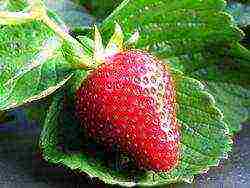Content
- 1 Valery Chkalov
- 2 Iput
- 3 Narodnaya Syubarova
- 4 Ovstuzhenka
- 5 Backyard yellow
- 6 Jealous
- 7 Tyutchevka
- 8 Fatezh
- 9 Cheremashnaya
- 10 Choosing a fruitful cherry variety for the Moscow region
- 11 What variety of cherries to choose for planting in the Moscow region
- 12 Early cherry varieties recommended for gardeners in the Moscow region
- 13 Medium fruiting trees for the Moscow Region
- 14 Cherry varieties with late ripening of berries for the Moscow Region
- 15 Varieties with extraordinary fruit color for sweet cherry lovers
- 16 Analysis of nutrient fertilizers and dressings to increase the yield of cherry varieties
- 17 Mistakes of novice gardeners, leading to a decrease in sweet cherry yields
- 18 Gardeners' Questions When Growing Cherry Trees
Is it difficult to grow cherries in the Moscow region, and what varieties are considered the most popular among summer residents? If you have asked this question at least once, then you need to get acquainted with the varieties we have described, and especially their self-fertile varieties.
Most of the known fruit crops are cross-pollinated. In other words, for fruiting, the ovary must be pollinated with pollen from a plant of a different variety. However, cross-pollination does not always take place in the right amount; bad weather interferes with it: rains, strong winds or cold weather. Therefore, self-fertile varieties were bred, in which pollination occurs within the same tree. Their feature is the specific structure of the flower, the pistil and stamens in it are at the same height, and pollination occurs in an unopened flower. This guarantees a high degree of pollination and minimal yield losses. However, most varieties are still partially self-pollinated and self-fertile, and for abundant fruiting they need other cherry trees as pollinators.
Valery Chkalov
The trees of this variety, named after the famous pilot, grow to a height of 5-6 m. The fruits are rather large, wide-heart-shaped with a blunt top. The color of the cherry is dark red or maroon. The pulp is bright red, juicy, with a pleasant dessert taste. The fruits are suitable both for eating raw and for preservation. Cherry varieties Aprelka, Bigarro, Zhabule, June early, Skorospelka are used as pollinators. The plant can tolerate frosts down to –30 ° C. Anyone who decides to plant this cherry variety on the site should be wary of gray rot and coccomycosis.
| Entering fruiting | Fruit weight (g) | Harvest | Productivity (kg per tree) | Peculiarity |
| 5 year | 6-8 | First-second ten days of June | 20-30 | In the southern regions, fruiting reaches 65-70 kg per tree |
Iput
One of the best partially self-fertile varieties. A tree of medium height with a broad-pyramidal and leafy crown. Fruit size varies from medium to large, heart-shaped, color during ripening changes from dark red to charcoal black. The yield is stable, the trees are highly resistant to fungal diseases. The plant and its parts tolerate well even severe frosts and long winters. The only drawback of the variety is that the fruits can crack due to the abundance of moisture.
| Entering fruiting | Fruit weight (g) | Harvest | Productivity (kg per tree) | Peculiarity |
| 5 year | 5-7 | End of June | 30-40 | Dense and aromatic pulp |
Narodnaya Syubarova
The advantage of this variety is that it is suitable for growing in almost any climatic zone. The mature tree is powerful and tall, with well-developed branches and trunk. It can withstand both heavy snow cover and strong winds. Saplings take root well even on loamy and sandy loam soils. It is completely self-fertile and does not need the help of other pollinating trees. The skin of the fruit is dark red with a waxy coating, with the same color pulp and pleasant taste.
| Entering fruiting | Fruit weight (g) | Harvest | Productivity (kg per tree) | Peculiarity |
| 4 year | 4-6 | 2-3 decades of July | 35-50 | Coccomycosis resistance |
Ovstuzhenka
It is the most cold-resistant variety, the trees can withstand frosts down to -45 ° C. Conditionally self-fertile, since pollination occurs within one tree, and the number of formed ovaries is 5-10%. The compact size of the tree allows it to be planted on an industrial scale. Cherry varieties Iput, Raditsa, Revna and Tyutchevka are best suited for pollination. The berries are large, dark and very sweet.
| Entering fruiting | Fruit weight (g) | Harvest | Productivity (kg per tree) | Peculiarity |
| For 4-5 years | 4-6 | Early to mid-July | 15-25 | Berries practically do not crack |
Backyard yellow
The tree is tall, within several years it reaches a height of 3.5-4 m. The crown is spherical, slightly thickened. The fruits are large, slightly elongated, with a sunny yellow color and light yellow pulp. The variety is early maturing, retains resistance to both prolonged winter frosts and recurrent frosts. Differs in high productivity and resistance to typical diseases of fruit trees.
| Entering fruiting | Fruit weight (g) | Harvest | Productivity (kg per tree) | Peculiarity |
| For 5-6 years | 5-6 | Early July | 40-60 | Absolute self-fertility |
Jealous
This small tree with a pyramidal crown can often be found in the areas of sweet cherry lovers. The plant is very prolific and produces many small but sweet and aromatic berries every year. Even during the flowering period, it can withstand cold snaps down to –5 ° C. Sweet cherries can be stored for a long time and at the same time they remain strong and juicy. The berries are maroon, the pulp and juice are dark red. Suitable pollinators are Venyaminova, Iput, Compact, Ovstuzhenka, Tyutchevka.
| Entering fruiting | Fruit weight (g) | Harvest | Productivity (kg per tree) | Peculiarity |
| For 4-5 years | 5-6 | End of June - first half of July | 15-20 | Resistance to fungal diseases |
Tyutchevka
A "modern" cherry variety with many unusual characteristics. The tree is medium-sized, with a spherical compact crown. Differs in frost resistance and easily resists fungal and infectious diseases. The fruits are very large, in a fancy dark red plumage with surprisingly juicy and tasty red pulp. They are very convenient to collect - the sweet cherry easily breaks off the stalk, but the ripe fruits do not fall off, but continue to hang on the tree. When pollinated with pollen from trees of varieties Ovstuzhenka and Raditsa, the yield increases.
| Entering fruiting | Fruit weight (g) | Harvest | Productivity (kg per tree) | Peculiarity |
| For 4-5 years | 5-7 | Early July | 25-40 | One of the leaders in taste and appearance |
Fatezh
The tree grows to a height of 3-4 m, branches are spreading, forming a regular sphere. Plants should be planted in places protected from the wind, with access to sunlight. They do not need frequent watering and abundant fertilization. Berries are regular in shape, almost the same size and color (bright red with yellow spots). The pulp is juicy and separates well from the stone. The taste is sweet and sour, with tart notes. Sweet cherry is resistant to coccomycosis and moniliosis.
| Entering fruiting | Fruit weight (g) | Harvest | Productivity (kg per tree) | Peculiarity |
| For 4-5 years | 4-5 | July | 40-50 | The decorative appeal of the tree |
Cheremashnaya
An early ripe variety, the trees of which reach a height of 4-5 m. The crown is slightly raised, rounded-oval, medium thickening. Fruits are medium-sized, oval, rich yellow. Some fruits develop a bright pink blush. The pulp is dense and juicy, bright yellow in color. Sufficient winter hardiness for the Moscow region and adjacent regions. Also, the tree quite easily resists various fungal diseases. For pollination, the varieties Bryanskaya rozovaya, Iput, Krymskaya, Leningradskaya black, etc. are usually used.
| Entering fruiting | Fruit weight (g) | Harvest | Productivity (kg per tree) | Peculiarity |
| For 5-6 years | 4-4,5 | End of June | 15-25 | High in nutrients and sugars |
Taking our list as a basis, residents of the Moscow region will be able to enjoy excellent self-fertile and self-fertile varieties of cherries that are resistant to frost and disease, bear abundant fruit and grow for a long time in one place. Compare, try, choose and share your impressions in the comments.
 Sweet cherry is a southern crop, but there are varieties that can be grown in the Moscow region. In this article, everything is about proper planting, competent care, methods of breeding varietal cherries when grown in the Moscow region. Photos of the zoned varieties of culture in the photo gallery.
Sweet cherry is a southern crop, but there are varieties that can be grown in the Moscow region. In this article, everything is about proper planting, competent care, methods of breeding varietal cherries when grown in the Moscow region. Photos of the zoned varieties of culture in the photo gallery.
Varieties and varieties of sweet cherries for cultivation in the central regions of Russia
Sweet cherries and cherries are close relatives, but the sweet cherry tree is tall, sweeter berries and is traditionally grown in southern regions. Breeders of the central regions of Russia bred a number of cherry varieties adapted to the harsh conditions of Russian winters, as a result, the following varieties were recommended for the gardens of the Moscow region:
- "Iput" - delicacy sweet cherry with fruit weight up to 9 g, dark ruby color, with juicy and sweet pulp. The cherry tree is distinguished by its medium height, with a pyramidal crown. The variety is resistant to winter frosts and characteristic infections of sweet cherries. The purpose is universal.
- "Orlovskaya amber" - large cherry fruits have an excellent taste and are yellow-pink, fragrant, juicy. The fruits do not differ in large size - the average weight of one berry reaches 5.5 g.
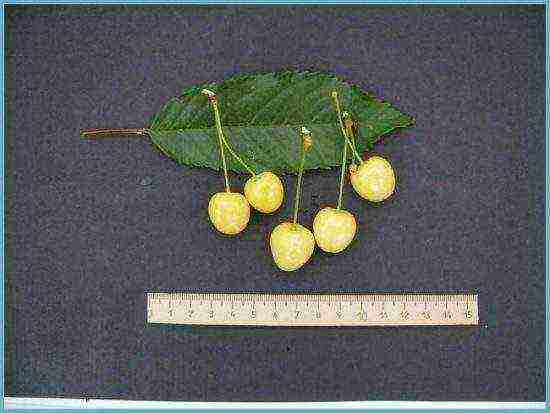
Orlovskaya amber
- "Raditsa" - a variety of sweet cherries with a high yield. Ruby-colored fruits with a pronounced delicious taste ripen by the beginning of summer. The purpose is universal.
- "Motherland" - a variety with high resistance to diseases, the fruits ripen early. The average weight of fruits reaches 5 g. During the ripening of cherries, it is not allowed to water the trees, otherwise the ripe fruits will crack.
- "Ovstuzhenka" - large round fruits of this variety have a dark ruby color, cherry ripens in early June. Winter hardiness, productivity and disease resistance are high.
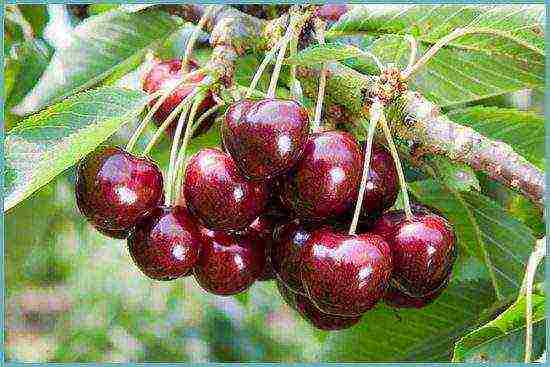
Ovstuzhenka variety
- "Victory" - a medium-ripening cherry variety, red dense berries ripen massively by the beginning of June. The yield is high.
- "Fatezh" - winter-hardy and productive variety with good disease resistance. Fruits are pink, medium-sized.
- "Bryansk pink" - the variety is late. Fruiting occurs in the 5th year. Berries are medium in size with dense yellow-pink flesh, sweet taste.
- "Revna" - a universal variety with black fruits. The pulp is dense, juicy, with a delicious taste. The variety is resistant to diseases and easily tolerates the harsh winters of the Moscow region.
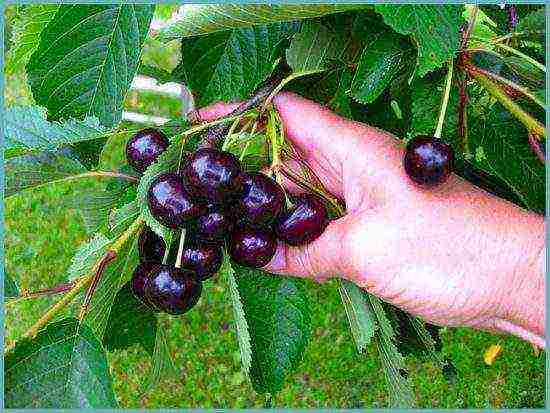
Revna varieties
- "Tyutchevka" - an excellent late variety with large, red fruits, which is resistant to classic diseases of the culture.
Advice! Among the cherries, there are self-fertile and self-fertile varieties. To ensure a high yield, it is worth planting trees of both groups when forming a garden.
Correct planting of cherries in the central regions of Russia, including the Moscow region
For a cherry orchard, it is worth choosing places protected from the wind with good illumination.Trees do not tolerate winter cold, therefore, it is necessary to choose zoned varieties with good winter hardiness.
In ventilated gardens, it is useful to arrange protective screens painted in white - this is the easiest way to provide plants with more comfortable conditions.
The soil for planting cherries should have a slightly acidic reaction and contain a lot of humus. The structure of the soil should not be dense, caked. It is important to protect the root system from excessive moisture, for which, when preparing the planting pits, reliable drainage from a layer of coarse sand or gravel should be provided.
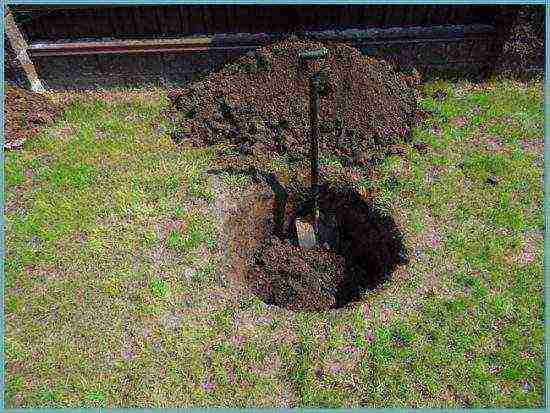
Preparing a pit for planting cherries
Planting cherry seedlings is allowed in spring and autumn. Preparing the soil for planting is reduced to deep plowing of the site and digging individual planting holes.
Advice! When planting cherries, remember that the tree has deep tap roots and a branched lateral root system.
The dimensions of the pits are 0.8 x 0.8 x 1.0; the distance between plants is from 3 to 5 meters. The pits are covered with a specially prepared soil mixture, which includes: nutrient soil, superphosphate, ammonium sulfate, ash, potash fertilizers, organic matter. For a drainage device, one or two buckets of sand or crushed stone are added to the bottom of the pit.
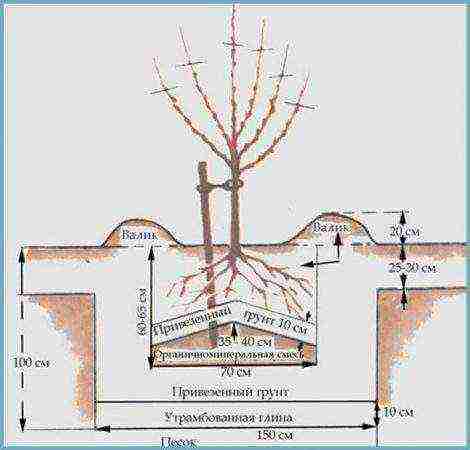
Scheme of the correct planting of cherries
The trunk of the seedling is placed on a mound of earth in a hole, carefully spreading all the roots. You can immediately put a peg in the center of the pit to support the weak stem of the seedling.
Important! You cannot fill up the root collar of the seedlings, they should protrude 3-5 cm above the ground.
The planted young cherries should be watered abundantly.
How to care for cherries in the Moscow region
In the garden, under each cherry tree, there should be a near-trunk circle with a diameter of at least a meter, in which it is important to periodically loosen the ground and free it from weeds.
Adult trees are watered at least 3 times per season, and to preserve moisture, it is useful to mulch the trunks with peat crumbs and humus.
To increase the yield of sweet cherries, the plants should be properly pruned. Distinguish between forming, sanitary and rejuvenating crown pruning.
- Anti-aging pruning carried out with a decrease in the yield of the tree. All branches on the tree are shortened to the length of annual shoots, with such pruning, the flower buds of the next year are not damaged and the development of new shoots is stimulated.
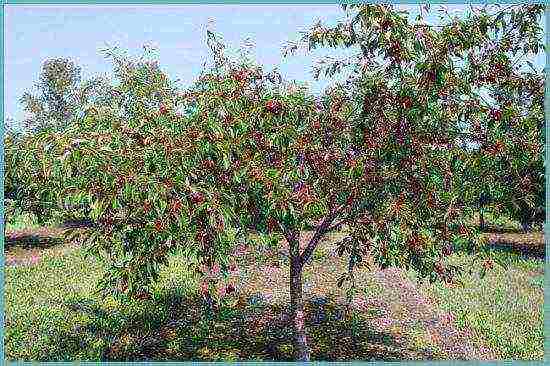
Pruning young trees is carried out in order to form the crown
- Sanitary pruning required for trees that have sustained damage to skeletal branches. The cuts are treated with paint or garden varnish to reduce the wound surface and prevent the spread of infections.
- Formative pruning carried out on young seedlings in the first year of planting, forming the skeleton of a tree in a classic sparse-tiered system of branches arrangement for sweet cherries. With such a crown, all branches of the tree are evenly illuminated by the sun, and unhindered ventilation is provided. Pruning scheme: in total, there are 6 to 8 main branches in the crown, which form three tiers.
Advice! Any branch pruning should be done prior to the start of the growing season.
The height of the trunk depends on the growing area, in the Moscow region it is necessary to leave the trunk high from 40 cm. The trunk is trimmed over the upper bud, the next year the 3 strongest branches are left in the crown and leave them no longer than half a meter. The central shoot is shortened to 4 buds.
What and when to feed cherries?
Young plants are quite satisfied with the set of nutrients that are laid in the pits when planting seedlings. In the first year, cherries do not need to be fertilized.
In the following years of cultivation, cherries need additional dressing in spring and autumn, while in the spring they apply fertilizers that stimulate growth - nitrogen. Potash and phosphorus compounds are introduced in the fall.
Advice! An overdose of nitrogen fertilizers leads to uncontrolled growth of the crown, which has a bad effect on future crops.
Cherry propagation
Stone fruits, when propagated by seeds, do not retain varietal characteristics, therefore this method is usually not used to expand the garden.
The best way to propagate cherries is graft, which is carried out by the copulation method. Cuttings of high-yielding varieties (scion) are grafted onto persistent young seedlings of cultivated varieties (stock). The grafted seedlings perfectly repeat the parental characteristics, retain high productivity and resistance to frost.
There is a possibility of propagation of the cherry tree by grafting, but the survival rate of cuttings is low, only up to 5%, so this method is read unproductive and is rarely used.
Sweet cherry: the main diseases of culture
Cherry has fewer diseases than other stone fruits, but the main diseases of the culture are coccomycosis and cherry moniliosis.
Moniliosis occurs when plants are infected with the pathogenic fungi Monilla cinerea. With the spread of the disease on a cherry tree, branches and leaves dry out, as well as rotting of fruits. The infection spreads quickly along the crown of the tree, especially in thickened plantings in low and humid places. Cool weather and frequent rainfall contribute to the disease.
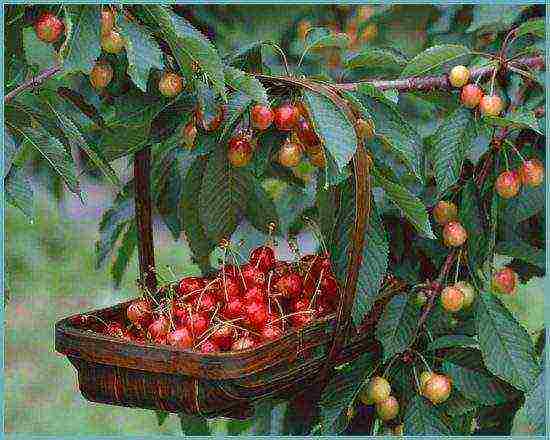
Treat the garden from pests
Coccomycosis - infection with the fungus Coccomyces hiemalis manifests itself on the leaf blades in the form of merging spots of small red dots. The infection infects plants in inclement weather. The leaves are affected by infections, gradually turn brown and fall off.
To fight infections, plants are treated with Horus at the rate of 30 g per bucket of water.
Advice! Soap should be added to the drug solution to form a thick foam. Spraying begins on the inside of the leaves.
Affected parts of diseased plants should be burned to prevent the spread of infections.
Of all the pests, the most malicious for sweet cherry is aphids - pest control is carried out with the help of special preparations.
Sweet cherry in central Russia: video
Growing cherries in the Moscow region: photos
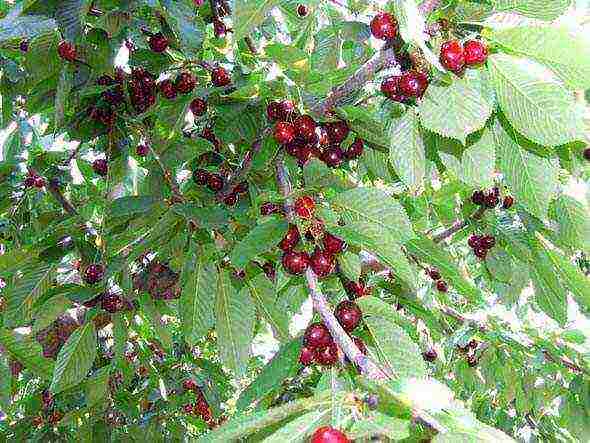
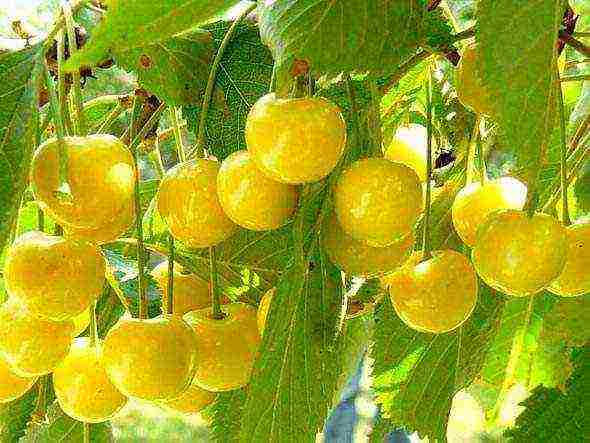
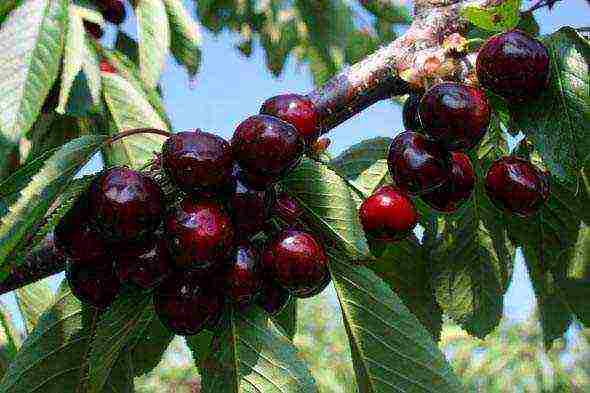
Sweet cherry is a southern culture. Previously, the middle region of our country was not suitable for growing this berry, and all because this plant did not survive in the harsh winters. Complex logistics, transportation costs, time - all this increased the cost of the final cost of the berry and made it truly "golden".
The most heart-healthy product
Today, breeders have developed many varieties that can grow in the northern regions. Yes, the yield will be less, the fruiting period is shorter, but the taste will not change from this. And how to choose cherries for the Moscow region, the best variety of which everyone determines for himself, you will learn from our article.
Choosing a fruitful cherry variety for the Moscow region
First of all, it is worth noting that this tree itself is very finicky, and even more so in conditions that do not meet the requirements of its growth. Some time ago, a large-scale destruction of cherry orchards was observed in the Moscow region, which served as the development and cultivation of new varieties of cherries. The best varieties of cherries and cherries, which can be grown in the northern regions of Russia, have not only excellent taste, but also disease resistance.
Most varieties tolerate transportation well.
The best cherry varieties for central Russia can grow fully under the following conditions:
- "Sparing" frosts;
- lack of sharp temperature changes;
- ensuring a sufficient amount of light and heat during flowering and ripening of fruits;
- timely care, cultivation and watering;
- regular fertilization of the soil.
The best varieties of cherries that can be grown in the Moscow region do not tolerate both early and late frosts in the autumn and spring seasons, at a time when the sap flow either has not yet ended or has already begun.
To increase the yield of cherries, regular fertilization of the soil is imperative. Otherwise, the fruits will be small and not juicy.
Today, every experienced gardener is already familiar with all the best varieties of sweet cherries that can be grown in the Kuban, Krasnodar and Altai Territories. Whereas inexperienced landowners will probably be interested to know what species of this plant can easily grow in cold regions.
Read with this article: Wood ash as soil fertilizer
Rating of the best varieties of sweet cherries by yield
The best varieties of cherries for the Moscow region, the forum about which allows you to find out all the details of growing this berry, have already managed to prove themselves well as the most persistent and fruitful. But at the same time, you should not completely trust the breeding data and let the cultivation of a thermophilic tree take its course. To get an excellent harvest, it is worth taking care of both the process of planting the seedling and the timely fertilization of the soil. This is the main condition for obtaining high yields.
Narodnaya Syubarova
One of the best self-fertile cherry varieties for cultivation in the northern regions is distinguished by the fact that it takes root in almost any climatic zone. The five-year-old tree has a well-developed branching system and trunk. And the crown of such a plant is strong, capable of protecting internal tissues from frost and other negatively influencing factors.
Variety Narodnaya Syubarova
Saplings of the People's Subarovaya cherry take root in the Crimea, Ukraine and even in the Volgograd region and have a unique resistance to coccomycosis. High-quality maturation is possible both in loamy and sandy loam soil. Such a plant belongs to the self-fertile group that does not need the help of other pollinating trees.
The large fruit has a juicy burgundy flesh, a pleasant sweet taste, while the rind is distinguished by a waxy bloom. The berry is harvested from a four-year-old seedling. Fruit weight fluctuates within 4-6 grams, and a large harvest can be obtained from a tree - up to 50 kg of fruits. This variety can be said to be "quality + quantity". The ripening period is the end of July.
Iput
Self-fertile sweet cherry, mid-season, begins to bloom in the second decade of May. But the harvest takes place in the first ten days of July. Decorate any garden with its beautiful and voluminous deciduous system. The fruits are burgundy, rarely dark pink. And if the site is well fertilized, then they can have a practical black color. The frost resistance of this tree is extremely high.
Variety "Iput"
The berry is large, weighing up to 6 grams. But in order to grow this type of plant, you need to adhere to all the rules and techniques of agrotechnical care for it. The tree is not pollinated, so it is extremely important during the period of ovary formation to make every effort to lure insects onto it. This is the only way to get a high yield.
Ovstuzhenka
The best cherry variety for the Moscow region, reviews of which are only positive. This is due to the high level of cold resistance - the plant is able to withstand frosts down to -45 ° C. Due to the fact that the height of the tree is no more than 2.5 meters, it is most often planted on an industrial scale.
Ovstuzhenka
The berries are dark red and can weigh up to 6 grams. Begins to bear fruit in the fourth year of growth. Up to 25 kg of fruit can be harvested from a tree. This frost-resistant species is very popular with both experienced gardeners and beginners. Tyutchevka, Ipun, etc. are suitable for pollination.
Cheryomashnaya
This is a southern hybrid species, the height of the trees of which reaches 5 meters. The berries are yellow in color, medium in size and oval in shape. In sultry heat, the fruits may be with a pink barrel. Due to its good winter hardiness, this species is able to grow in the Moscow region and adjacent regions.A distinctive feature of Cheremashnaya is its high resistance to various fungal infections. Pollinating varieties - Ipun, Valery Chkalov, Priusadebnaya yellow, etc.
Cheryomashnaya
Description of the species: fruiting begins in the fifth year of ripening. The weight of one berry reaches 4.5 grams, and up to 27 kg of fruits can be harvested from one tree.
Jealous
The plant has a pyramidal form of development of the deciduous system. For the most part, this variety decorates "home" gardens. The tree bears many fruits, and, despite its small size, they are distinguished by excellent taste and unique aroma. During the flowering period, the fruit seedling is able to withstand minor frosts - up to -7 ° C.
Jealous
Distinctive feature:
- long shelf life;
- high resistance to fungal infections.
The berry has a maroon color, juicy and firm. The beginning of fruiting occurs in the fourth year of growth. The crop is ready to be harvested in the first decade of July.
Tyutchevka
Differs in high fruiting. The fruits are maroon, and sometimes even black. Distinctive feature:
- long peduncle;
- good transportability;
- long shelf life;
- large berry sizes - up to 7 grams;
- pleasant, tasty aroma and honey taste;
- self-pollination.
Backyard yellow
A tall seedling that grows up to four meters over three years. The berries are large, slightly elongated and bright yellow in color. A type of early ripening period, it is able to maintain resistance to prolonged frost. Differs in good productivity and resistance to typical diseases of fruit trees.
Backyard yellow
The beginning of fruiting occurs in the sixth year of ripening. Whereas the first sweet cherries can be harvested in the second decade of July. The weight of the berry is up to 6 grams, and up to 60 kg of the crop can be harvested from one tree.
Now you know which cherry varieties are better to plant in the Moscow region. We hope these tips will help you make the right choice and grow beautiful and fruitful fruit trees in your garden.
Cow heart
A worthy example of the best cherry varieties for the Crimea. One of the largest, juicy, aromatic berries. Early flowering - May-June. Ripens in the middle of summer. Begins to bear fruit 5 years after planting the seedling. The yield is very high - an average of 100 kg per tree.
Cow heart
The variety is frost-resistant, not susceptible to attack by insects and fungi. Requires fertile soil and deep soil. It can die within a month if the root starts to rub against hard rocks.
VIDEO: The best varieties of cherries
To grow a decent harvest of cherries in the Moscow region, you need to carefully consider the choice of the variety. The yield of the tree directly depends on its characteristics. A competent combination of flowering period, winter hardiness, exactingness to the soil composition allows you to achieve a result with minimal effort. On the contrary, a frivolous attitude towards the type of tree will not allow you to get a high yield, even with increased costs. In the article we will tell you about the best varieties of cherries for the Moscow region, we will give their detailed characteristics.
What variety of cherries to choose for planting in the Moscow region
Cherry trees prefer fertile soil and good lighting. In the Moscow region, these conditions are rarely combined. Therefore, the efforts of breeders are directed towards the development of new varieties suitable for the conditions of the region. Cold-resistant varieties of sweet cherries that grow in the Moscow region are presented below.
Sweet cherries are a great treat for children and adults
Late cherry - Bryansk pink
Bears fruit in the 4th year of life. They are pinkish, round in shape with yellowish flesh. It belongs to a self-fertile culture, therefore it requires an additional pollinator partner. Blooms in early May.For pollination of a tree, another variety of cherries are planted with an identical flowering period. An adult tree grows up to 2.5 m, the density of branches is medium.
The lack of a variety type (inability to self-pollinate) is overcome by a variant of a number of planted varieties such as "Revny", "Tyutchevka" or "Iput". The advantages of the variety are resistance to winter cold and habitual diseases, good transportability.
Yield grade Iput
The crop is harvested in the form of burgundy berries, with high-quality juiciness and sweetness. Fruiting in 5 years, but also refers to self-fertile early cherries. Paired with the previous variety, it gives a decent harvest. The tree grows tall, an adult cherry tree reaches 4 meters in height. The crown is pyramidal, strongly leafy and dense. The advantages of the variety:
- frost resistance;
- resistance to fungal infections;
- annual yield;
- dense strong flesh of berries;
- carries long distance transportation.
A tree with a crown of an unusual shape - Tyutchevka
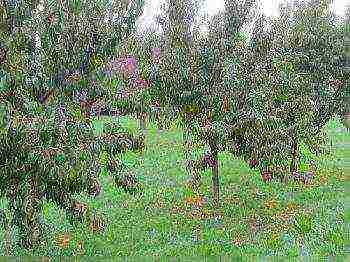
Plant partner cherry varieties nearby to increase yields.
The height of the sweet cherry does not exceed 3 meters. The color of the berries is burgundy or dark red. Good quality juiciness and sweetness. Blooms late, also bears fruit at a later date. The first tasty harvest can be removed 5 years after planting. The advantages of the variety:
- self-pollination;
- transportability;
- disease resistance;
- high productivity;
- winter hardiness.
A variety with an unusual shape of berries - Revna
This variety has an expanded funnel with a round top. The color is burgundy, juiciness and sweetness are appreciated by gardeners. Fruiting begins at 4 years of age. Refers to self-pollinated, but the simultaneous planting with cherries "Iput", "Raditsa" increases the yield. Benefits that are noted:
- fruits of high quality, with varietal characteristics;
- transportability of berries;
- frost resistance;
- the plant does not respond to sunburn.
Tip # 1. Plant several trees of different varieties in the garden at the same time, but of the same ripening period, for additional pollination.
Early cherry varieties recommended for gardeners in the Moscow region
The listed varieties are resistant to winter cold. Simultaneously with the name you like, purchase pollinators for joint planting.
| Name | Advantageous features | Flaws |
| Gronkavaya | Fruit for lovers of dessert taste. | Pollinators required. The best are Iput, Raditsa, Fatezh, Cheremashnaya, Ovstuzhenka. |
| Backyard yellow | Self-fertile. A vigorous tree. Winter hardy. Sour fruits. |
Begins to bear fruit after 8 years. |
| Red hill | High quality fruits. Transportability. |
Susceptible to disease. Pollinators required. The best are Tyutchevka, Raditsa, Ovstuzhenka. |
| Ovstuzhenka | Self-fertile partially. The fruits are of high quality. |
Disembarkation at the same time with Iput cherries. |
Medium fruiting trees for the Moscow Region
Mid-season varieties are planted in pairs, which mutually increases the yield of varieties. Recommended combinations:
- In memory of Chernyshevsky + Adeline. Both with the same low temperature tolerance and fruit characteristics.
- Tyutchevka + Raditsa. Trees of the same size with good resistance and tasty fruit.
| Name | Description | Unsatisfactory parameters |
| Rechitsa (bigarro group) | Frost resistance.
Disease immunity. The sweetness of the fruit. |
Not large fruits.
Requires pollinating neighbors (Adeline, Ovstuzhenka, Pink Pearl) |
| Leningrad black (gini group) | Extraordinary coloring.
The sweet taste of ripe berries. |
The pulp is difficult to separate from the seeds.
Not resistant to severe frosts. Not self-fertile. |
| Leningrad pink (gini group) | Delicate pleasant berry taste.
Lush crown. |
Not self-pollinated.
The fruits are small. Pollinators - Rechitsa, Adeline, Pink pearls. |
| Large-fruited | Large fruit with dessert flavor.
Fast growing tree. |
Requires pollinators - Oratovsky, Surprise. |

Cherry variety Leningradskaya pink
Cherry varieties with late ripening of berries for the Moscow Region
The first harvest of cherries has to wait for more than one year. Therefore, when buying a seedling, consult about the characteristics of the variety and purchase species compatible for pollination. The second option is to inoculate a pollinator variety on existing trees. Read also the article: → "How to properly plant fruit trees in spring, summer, autumn."
Late-ripening cherry varieties for the Moscow region include:
- Michurinka. Medium-high sweet cherry with immunity to diseases and good drought and frost resistance. Berries are always well preserved during transportation, do not spoil for a long time during storage. The meatiness and strength of the berries is combined with a taste that leaves a pleasant sensation. It is not capable of self-pollination. Pairs for planting - Pink pearls, Michurinskaya late.
- Bryansk pink. The taste of ripe berries is an important criterion for the variety. The cherry variety is sweet and juicy. The disadvantage is that the pulp and pits are difficult to separate. The variety is drought and winter hardy, resistant to habitual crop diseases. The tree grows up to 3.5 meters in height. The partner pollinators for the named variety are Iput, Tyutchevka, Revna.
Varieties with extraordinary fruit color for sweet cherry lovers
In addition to the usual red shades, there are cherry varieties for the Moscow region with a creative color - yellow, black. To choose a yellow cherry for planting, it is worth learning about its undeniable advantages over the usual one. The main advantage is that yellow fruits are not pecked by birds, which allows you to harvest in full. The second advantage is the quality of the fruit, which does not crack in heavy rain.
- Household Yellow. It ripens early enough, but is not afraid of frost. Prefers black soil, suitable for growing in the climatic conditions of the Moscow region. Sweet cherry is self-pollinated and fruitful. Begins to harvest late - not earlier than the 6th year. Does not suffer from cherry flies and common culture diseases. The disadvantage is active reproduction, which requires the gardener to constantly prune the tree and remove the growing shoots. Read also the article: → "How to prune cherries correctly: instructions for beginners, diagram, pruning time."
Cherry variety Home Garden Yellow
- Drogana is yellow. Mid-season type of sweet cherry with good frost resistance. A variety with a high level of adaptability to climatic changes. The fruit is heart-shaped with a thin skin. Advantages - drought and frost-resistant, high-yielding, the berry does not fall from the tree.
Flaws:
- tall tree, which has to be taken into account by the owners of small plots;
- poor transportability and cracking of fruits;
- not capable of self-pollination;
- affected by a cherry fly.
Black-fruited varieties are interesting to gardeners for their extraordinary color. Pay attention to:
- Rechitsu. Mid-season cultivar with excellent frost resistance. The tree is average, relatively unpretentious to the soil composition. The berries are resistant to cracking, the bone is easy to separate from the pulp. Disadvantages - poor yield, requires partners-pollinators.
- Leningrad black. The harvest ripens in the middle of the crop. The fruits are medium-sized but sweet. Cherry height is 3 meters. Disadvantages - average winter hardiness, the bone is difficult to separate from the pulp, requires planting in pairs (Iput, Tyutchevka, Revna).
- Ovstuzhenka. A variety of medium sweet cherries with good juiciness and sweetness that are not prone to cracking. It tolerates frosts near Moscow, does not get sick with ailments familiar to culture. The disadvantage is poor productivity, requires pollinating neighbors (Iput, Raditsa, Tyutchevka).
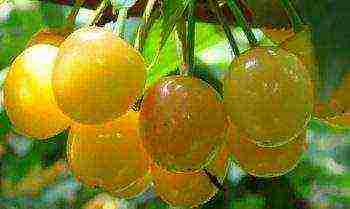
Plant yellow cherries in your garden to prevent birds from destroying crops.
Analysis of nutrient fertilizers and dressings to increase the yield of cherry varieties
Gardeners recommend applying the following types of fertilizers:
| Name | Advantage | Flaw |
| Organic fertilizers (humus, compost) | Complex of useful substances.
Convenient form for applying to the soil. Natural composition. |
The need to dig into the ground. |
| Mineral fertilizers | Recommended dosage.
Various formulations. |
Overdose leads to negative consequences.
Precautions needed. |
| "DripFert" | Soluble fertilizer, easy to apply.
Use in different periods of the year. Competently selected composition. |
Foliar top dressing only |
| Siderata. | Rapid soil enrichment.
Ease of cultivation. Natural ingredients. Rich in nutritional composition. |
The need to water the dug up mass for quick fermentation |
Tip # 2. Apply fertilizers only to the near-stem circles, avoiding direct contact of the substance with the tree trunk.
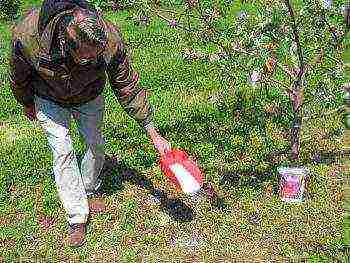
Fertilize carefully when root feeding so as not to harm the root system of the tree.
Mistakes of novice gardeners, leading to a decrease in sweet cherry yields
- Planting a tree in an area with a lack of lighting. Growth slows down, branches stretch out, fruits are formed only on the upper branches.
- Illiterate choice of soil. Favorable soils are light, non-saline chernozems, chestnut soils.
- Excessive application of nitrogen fertilizers. Young trees grow vigorously, the wood is not durable, freezes in winter and dies prematurely. Introduces mineral fertilizers in a dosage manner, even with a dosage limitation.
- A frivolous attitude towards damage to the tissues of the bark and root system of sweet cherry. Pathogens penetrate into the wounds, causing diseases and death of the tree. Avoid damage by shallow tillage.
- Illiterate crown formation. Cherries have a weak shoot-productive capacity after 5 years of life. Without shortening the growths, the crown becomes sparse, elongated with bare skeletal branches. Read also the article: → "Ways of forming the crown of fruit trees."
- Failure to comply with the rules for laying a garden. Sweet cherries are planted by selecting partner varieties that provide cross-pollination.
Gardeners' Questions When Growing Cherry Trees
Question number 1. Is it necessary to mulch the soil in the garden where cherries grow?
Mulching in the garden is an effective technique that is little used by summer residents. The soil is covered with organic matter 7-10 cm thick. Horse manure, rotted cow manure, is suitable. Compost is used in the composition:
- peat;
- leaves;
- sawdust;
- manure (required).
Mulch makes the soil loose, fertile and moist with active reproduction of earthworms. Plant nutrition is improving.
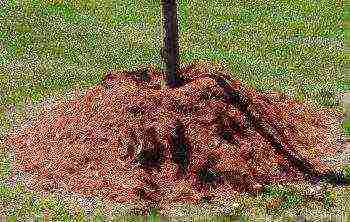
Be sure to mulch the near-stem circles to maximize yields.
Question number 2. How to choose good cherry seedlings for planting?
Seedlings are chosen taking into account the rules and indicators. Take one- or two-year-old seedlings without being tempted by beautiful three-year-olds. Further:
- developed fibrous root system (32-35 cm);
- the absence of "warts" (cancerous growths) on it;
- the thickness of the one-year trunk is 1 cm, the biennial one is up to 2 cm (at a distance of 30 cm from the root collar);
- two-year-old seedling 1.5 m high, one-year old - 1 m;
- large, formed apical kidneys without signs of disease.
Question number 3. Tree care is competent, but cherries do not bear fruit, what is the reason?
For cherries, pollen from other trees is needed for pollination. Therefore, a couple of varieties of cherries are planted nearby. In this case, the timing of the blooming of the "neighbors" is taken into account. They must match. Another reason is return frosts in spring, leading to the death of ovaries and flowers.
Question number 4. What is the fruiting time of the culture?
This is due to the variety and cultivation conditions. According to the rules, varieties bear fruit from 4-7 years after planting. This is subject to compliance with the requirements of care. The tenth year is considered to be the peak of fruiting.
Rate the quality of the article. We want to be better for you:


